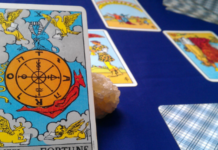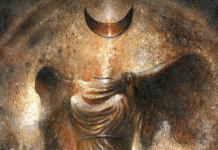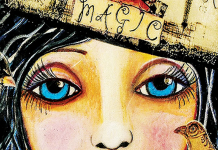
 The Fountain Tarot, created by Jonathan Saiz, written by Jason Gruhl, and designed by Andi Todaro
The Fountain Tarot, created by Jonathan Saiz, written by Jason Gruhl, and designed by Andi Todaro
The Fountain Tarot, 79 cards, 112 pp. booklet, 2015
The Fountain Tarot comes in an attractive shiny box, and the cards themselves have silver-gilt edges. Illustrated in a prismatic rainbow of pastels, the finish is matte rather than glossy, which allows the delicate detail of the original oil paintings to emerge. The cards are illustrated in a beautiful reinterpretation of Pamela Colman Smith’s artwork in the Rider Tarot, integrated with the sacred geometry that influenced Lady Frieda Harris in her illustrations for the Thoth Tarot, which ultimately gives it a more contemporary feel.
As with many decks published these days, The Fountain Tarot comes with 79 cards, consisting of the traditional 78-cards plus a bonus card. The extra card is called the Fountain, and is unnumbered, bearing instead a lemniscate representing infinity. The card itself represents the “eternal context beyond human experience in which anything and everything can happen.” Further, it’s a card of spirit, “the aether in which we navigate our imperfect lives and the substance of life itself.”1
The suits are Wands, Swords, Cups, and Coins, and follow their own colour system. The Swords are predominantly painted in a steely blue, Cups in a deeper shades of blue, Pentacles in greens, and Wands in yellows. In this deck, Wands are associated with fire; Swords with air, Cups with water, and Coins with earth – which happens to be the elemental configuration I prefer working with, so it was easy to find my bearings when reading with this deck.
The accompanying booklet gives the obligatory history of tarot, briefly, but accurately, and outlines the Fool’s Journey, as described by Robert Place, as well as the different divinatory expectations between the trumps and the suit cards, the former being archetypes, and the latter seen more as relating information about day-to-day life.
Several sample spread configurations are given to get one started. Beginning, of course, with the various applications of the three card spread, as well as a five card spread called, inevitably, the Fountain Tarot Spread. The Celtic Cross is also given, though here this is simply listed as a 10-card spread.
Each card comes with a description that hints at its divinatory meaning, as well as a list of keywords for upright and reversed interpretations. As seems to becoming ever more common with modern decks, each card also has its own motto or supreme keyword associated with it, most of which differ from the traditional Golden Dawn associations, and this is a welcome change. It’s nice to see tarot’s continuing evolution, and the direction new artists and writers are taking it.
Among the trumps, the Fool is tagged as “Boundless Innocence,” where the Magician is “Possibilities Revealed,” the High Priestess is “Veiled Wisdom,” and so on. These meanings come through clearly in the unbridled joy of the Fool child leaping from point to point. The turban-wrapped head of the Magician exudes possibility as he flips a coin, suspended around which are the remaining emblems: a clear bowl, sword, and wand. Over this collection of elemental weapons floats a lemniscate. Seated on a crescent moon throne, the High Priestess is veiled before gossamer white and black curtains, arc lightly painted to reveal a full moon. The trumps are sumptuously rich in their meaning, potent and beautiful.
The suit cards show the most marked departure from the Golden Dawn mottoes, and sometimes with their imagery as well, though their echo is still present. The Ace of Wands is “Passionate Energy,” the Five of Swords is “Tainted Victory,” the Nine of Cups is “Shared Happiness,” and the Knight of Coins is “Methodical Victory.” In the Ace of Wands a shard thrusts forth from the darkness, radiating prisms of light. The Five of Swords shows a figure victorious, though behind him two faded figures recede into the background. The Nine of Cups shows a bearded man cupping a golden bowl, eight other bowls before him, laughing with someone or something out of frame. Perhaps he’s sharing his happiness with us, as subjects of the reading? The Knight of Coins shows a figure standing at the threshold of an archway, lush greenery beyond, the sun shines high and bright, its rays bathe him as he offers the coin to the light.
The Fountain Tarot is so visually stunning, that it’s surprising how subtle it can be. It would be best suited for introspective or meditative readings.
- p. 6 [↩]








